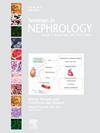中美洲北部的儿科肾脏护理:儿科肾病专家的调查。
IF 3.5
3区 医学
Q2 UROLOGY & NEPHROLOGY
引用次数: 0
摘要
慢性肾脏疾病(CKD)是一个全球性的公共卫生问题。危地马拉、萨尔瓦多、洪都拉斯和尼加拉瓜是非洲大陆因慢性肾病死亡率和寿命损失最高的六个国家之一。在中美洲北部提供儿科肾脏护理方面的差距之大从未有过系统的记录,这阻碍了规划预防和有效管理的可能性。向上述国家的儿童肾脏护理转诊中心主任发送了一份调查,以了解这些项目的流行病学和现状。该地区总人口为4040万;1700万(41%)年龄在21岁以下。儿童肾衰竭(pKF)的中位发病率为8.4 /百万年龄相关人群(pmarp),中位患病率为34pmarp。腹膜透析(PD)是最普遍的肾脏替代治疗(KRT)形式的连续动态腹膜透析(CAPD)。26.5%的患者使用血液透析(HD), 30%的患者有动静脉瘘(AVF)。很少有儿童获得移植(0.9移植pmarp)。儿科肾病专家的pmarp比率在洪都拉斯的1.5到危地马拉的2.3之间。公共卫生系统为所有四家转诊中心提供资金,但肾脏基金会发挥着至关重要的作用。这篇文章提供了见解,以支持多国计划的发展,有效的管理和战略利用现有资源,为儿童肾脏护理,包括国家和国际倡议的支持。本文章由计算机程序翻译,如有差异,请以英文原文为准。
Pediatric Kidney Care in Northern Central America: A Survey of Pediatric Nephrologists
Chronic kidney disease (CKD) is a public health problem worldwide. Guatemala, El Salvador, Honduras, and Nicaragua are among the top six countries of the continent with high mortality and years of life lost attributable to CKD. The magnitude of the gap in delivering pediatric kidney care in northern Central America has never been systematically documented, hindering the possibility of planning prevention and effective management. A survey was sent to the directors of pediatric kidney care referral centers in the aforementioned countries to understand the epidemiology and current state of the programs. The area has a total population of 40.4 million; 17 million (41%) are younger than 21 years. The median incidence of pediatric kidney failure (pKF) was 8.4 per million age-related population (pmarp), and the median prevalence was 34 pmarp. Peritoneal dialysis (PD) was the most prevalent kidney replacement therapy (KRT) in the form of continuous ambulatory peritoneal dialysis (CAPD). Hemodialysis (HD) was used in 26.5% of patients, and 30% had an arteriovenous fistula (AVF). Few children had access to transplantation (0.9 transplants pmarp). The rate of pediatric nephrologists pmarp ranged between 1.5 (Honduras) and 2.3 (Guatemala) pmarp. The public health system funds all four referral centers, but kidney foundations play an essential role. This article offers insight to support the development of a multinational plan for prevention, effective management, and strategic use of available resources for pediatric kidney care, including support from national and international initiatives.
求助全文
通过发布文献求助,成功后即可免费获取论文全文。
去求助
来源期刊

Seminars in nephrology
医学-泌尿学与肾脏学
CiteScore
5.60
自引率
0.00%
发文量
27
审稿时长
6-12 weeks
期刊介绍:
Seminars in Nephrology is a timely source for the publication of new concepts and research findings relevant to the clinical practice of nephrology. Each issue is an organized compendium of practical information that serves as a lasting reference for nephrologists, internists and physicians in training.
 求助内容:
求助内容: 应助结果提醒方式:
应助结果提醒方式:


